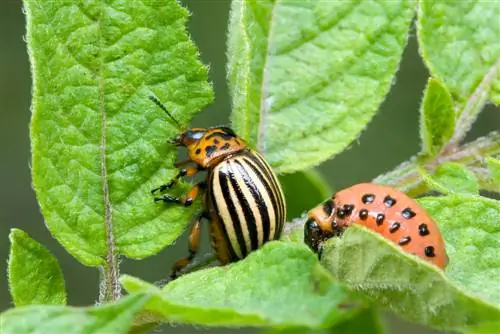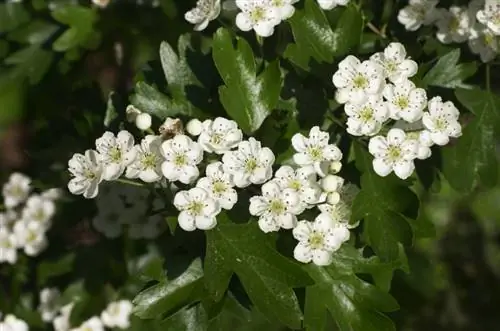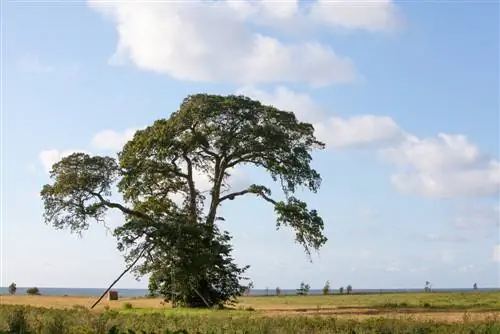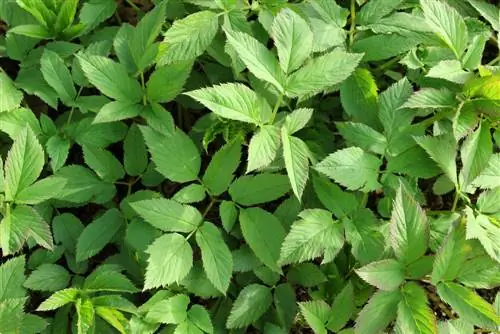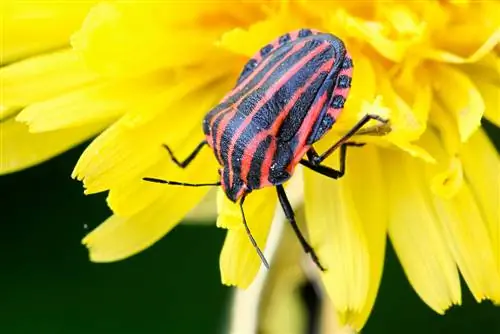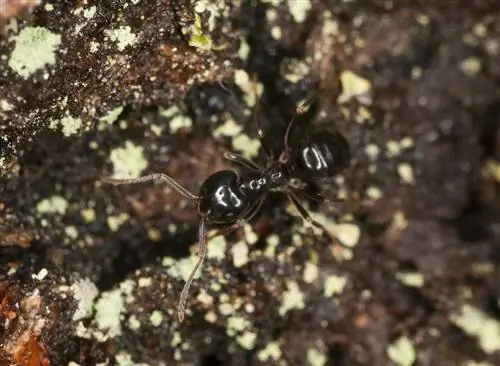- Author admin [email protected].
- Public 2023-12-16 16:46.
- Last modified 2025-06-01 06:02.
In Germany we share our nature with an abundance of small and large, black-brown and colorful beetles. Native species from 10 well-known beetle families are often found. This guide provides practical assistance in identifying beetles.
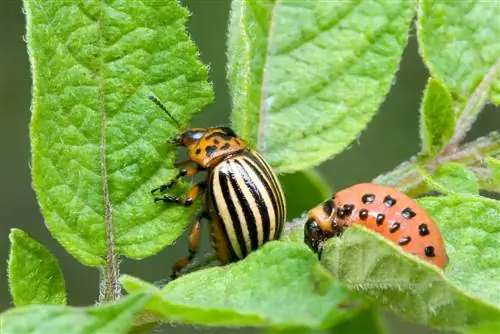
Which native beetles are there in Germany?
Native beetle species belong to 10 well-known beetle families such as weevils, longhorned beetles, ground beetles, bark beetles, weevils, leaf beetles, colored beetles, lady beetles, jewel beetles and shine beetles. Typical beetle characteristics are 2 pairs of wings, 6 legs, 2 antennae, biting-chewing mouthparts and a body structure consisting of a head, pronotum and cover wings.
- Certain beetle characteristics include body structure with head, pronotum and 2 pairs of wings (hardened cover wings over membranous wings), biting-chewing mouthparts, 6 legs and 2 antennae
- Native black-brown beetle families are weevils (Curculionidae), longhorn beetles (Cerambycidae), ground beetles (Carabidae), bark beetles (Scolytinae) and weevils (Lucanidae)
- Native colorful beetle families are leaf beetles (Chrysomelidae), painted beetles (Cleridae), lady beetles (Coccinellidae), jewel beetles (Buprestidae) and shiner beetles (Nitidulidae)
Identifying beetles - typical characteristics
Beetles represent the largest order within the class of insects. So far, there are 180 beetle families around the globe with more than 350.000 species known. There are an estimated 20 beetle families with around 8,000 species native to Central Europe. Given this dizzying diversity, native beetles come in a variety of shapes and colors. This circumstance does not make it easy for the layperson to make an informed determination. After all, beetles are characterized by these typical characteristics that clearly distinguish them from other insects:
- Body structure: head, pronotum, cover wings (with or without scutes)
- Wing structure: 2 pairs of wings, sclerotized (hardened) cover wings at the front, membranous, folded hind wings
- Mouthparts: biting-chewing
- Size: 0.5 to 80 mm (European species)
- Extremities: 6 legs and 2 antennae (short, long, thread-like, culled, fanned, combed)
- Eyes: Compound eyes
The main distinguishing features from other insects are body structure and wing structure. The classic insect structure of head, chest and abdomen does not apply to a beetle's body. Here the chest and abdomen form a visual unit, covered by often hardened cover wings, under which there are skin wings. The pronotum is usually visible on the top of the beetle. This structure gives many beetles a tank-like appearance.
Excursus
Beetles in the house - a double-edged sword
Little black and brown beetles severely test our appreciation for insects. Grain beetles (Sitophilus granarius), flour beetles (Tenebrio molitor) or fur beetles (Sitophilus granarius) boldly invade the house, contaminate food and destroy our belongings. Nevertheless, valuable beneficial insects sometimes get lost in the apartment in the desperate search for a winter quarters, such as ladybirds (Coccinellidae) or horse beetles (Malachiinae). Nature lovers always take the time to properly identify beetles so that no innocent beneficial insect has to lose its life for the infamous pests.
Identify black-brown native beetles - 5 common species
The color is an important criterion for the beetle layman on the way to accurate identification. Size, body shape, special characteristics and occurrence provide further clues for finding a name. The following table gives an overview of 5 common beetle families in Germany that have chosen a dark color. A typical native beetle species is named as a representative of each beetle family.
| Dark colored beetle families | Weevils | longhorn beetle | ground beetles | bark beetle | Schröter |
|---|---|---|---|---|---|
| Botanical name | Curculionidae | Cerambycidae | Carabidae | Scolytinae | Lucanidae |
| Color tone | black to dark brown | black, gray or colorful | black to shiny-colorful | brown-black to copper colored | black, reddish brown to red |
| Size | 3-20mm | 10-30mm | 1-85mm | 2-8mm | 8-80mm |
| Body shape | oval | elongated, stretched | flat, elongated | cylindrical, cylindrical | elongated to cylindrical |
| Special feature | long trunk | long antennae | long hind legs | serrated elytra edges | enlarged upper jaw |
| Occurrences | Forest, garden | inside, outside in the wood | in the leaf litter | on conifers | in/on deadwood |
| Typical style | Furrowed Black Weevil | Hausbock | Large Broad Beetle | Printer | Stag Beetle |
| Botanical name | Otiorhynchus sulcatus | Hylotrupes bajulus | Abax parallelepipedus | Ips typographus | Lucanus cervus |
We present the representatives of each beetle family in more detail in the following short portraits with tips on specific characteristics.
Weevil - Furrowed Weevil (Otiorhynchus sulcatus)
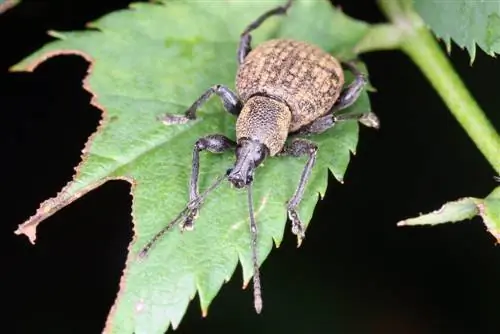
Weevils are feared plant pests
Of the approximately 1,000 species of weevils found in Germany, the furrowed weevil is the best-known representative. Identifying features are:
- 10 mm tall
- long trunk as head extension
- black upperside with dark brown spots
The armor-like upper wings and legs with a thickened middle segment are striking.
Longhorn Beetle - House Longhorn Beetle (Hylotrupes bajulus)
If a beetle has the suffix “buck” in its name, alarm bells ring. Many species in this family are considered to be feared wood pests, such as the house beetle. This is how you can identify the beetle:
- 2-8 mm long and slim
- very long antennae (similar to the horns of an ibex)
- black with white patches of hair on the wing coverts
On closer inspection, small bumps or thorns can be seen on the pronotum as an additional identifying feature.
Ground beetle - large beetle (Abax parallelepipedus)
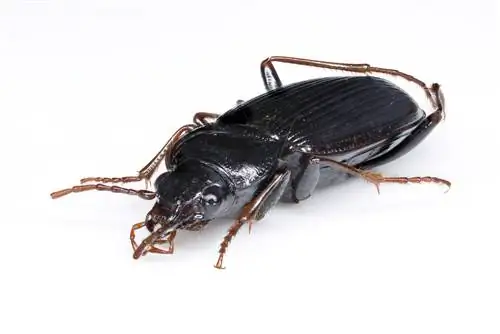
The ground beetle can grow up to 2cm in size
A magnificent specimen from the ground beetle family is the large broad beetle. The native beetle can be identified by these characteristics:
- 16 to 21 mm tall
- black, broad body
- 2 bristles over the compound eyes
- Longitudinal grooves on the elytra
Because our protagonist dresses in a dark beetle robe, he is represented in the table above. Shiny colors such as gold-yellow, blue or violet are also popular in the beetle family.
Bark beetle - book printer (Ips typographus)
If you notice dark beetle shapes on the bark of coniferous trees, you are most likely looking at bark beetles. A typical family member is the letterpress printer:
- 4.5 to 5.5 mm in size
- Elytra on the crash with 8 teeth
- silk matt dark brown colored
Characteristic of the letterpress is a solid shell that extends over the head.
Schröter - stag beetle (Lucanus cervus)
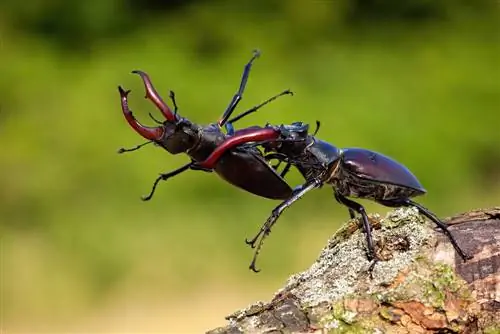
Stag beetles fight for their females
An encounter with a stag beetle makes our hearts beat faster, because the largest beetle in Germany does the honors. The native Schröter beetle can be identified by these attributes:
- 30 to 80 mm tall
- black-brown base color with reddish-brown cover wings
- The trademark of the males is an “antler” as a greatly enlarged upper jaw
In the following video, experience how Germany's largest beetle fights for the lady beetle of his heart. Ring free for the fascinating stag beetle:

Identifying colorful native beetles - 5 common species
If you come across a colorful beetle in Germany, it usually comes from one of five common beetle families. The following table focuses on beetle beauties that cause a sensation in blue, yellow, green or red. A representative from each family has the task of making beetle identification easier for you:
| Colorful Beetle Families | leaf beetles | Colored beetle | Ladybug | Pride beetle | soft beetle |
|---|---|---|---|---|---|
| Botanical name | Chrysomelidae | Cleridae | Coccinellidae | Buprestidae | Cantharidae |
| Colors | blue, yellow, red, green | colorful with stripes or dots | red, black, yellow | multifaceted colors | red, orange, yellow, blue, black |
| Size | 1-18mm | 3-40mm | 2-12mm | 2-30mm | 1, 2-15mm |
| Body shape | ovoid, curved | elongated | spherical | oblong-oval | elongated-flat |
| Special feature | artful, colorful patterns | thick hairy | dotted cover wings | big eyes | soft body |
| Occurrences | on plant leaves | on trees, bushes | highly arched body | on trees and bushes | Forests, meadows |
| Typical style | Potato beetle | Beetles | Sevenpoint | Linde beetle | Common soft beetle |
| Botanical name | Leptinotarsa decemlineata | Trichodes apiarius | Coccinella septempunctata | Scintillatrix rutilans | Cantharis fusca |
Further information about the ambassadors of local beetle families is summarized in the following short portraits:
Leaf beetle - Colorado potato beetle (Leptinotarsa decemlineata)
The leaf beetle family has to contend with the reputation of having numerous pests under its roof. The Colorado potato beetle is famous and infamous and can be recognized by this appearance:
- 7 to 15 mm in size
- yellow-black stripes
- yellow-orange neck shield with black dots
By the way, his voracious brood looks completely different. An insatiable Colorado potato beetle larva is red with two black rows of dots on each side.
Colored beetle - bee beetle (Trichodes apiarius)
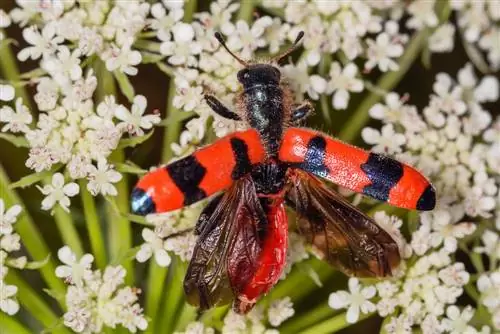
Colorful beetles are not really colorful, they are bright red - black
The family of colored beetles keeps what the name promises. This claim is convincingly demonstrated by the wonderful beetle. Significant features for a correct determination are:
- 9 to 16 mm in size
- bright red with black horizontal stripes
- Head, pronotum and legs green or blue metallic
Ladybird - Sevenspot (Coccinella septempunctata)
Germany's flying symbol of luck on six legs loves to eat aphids. For this reason, seven-spot ladybirds are welcome in every garden. This is what every child's favorite local beetle looks like:
- 5 to 8 mm in size
- red cover wings with seven black dots
- black neck shield with white corners at the front
For some time it was feared that sevenspot would be displaced by the immigrant Asian lady beetle (Harmonia axyridis). In recent years, the experts from the German Nature Conservation Association (NABU) have found that seven-spot ladybirds benefit from advancing climate change and can hold their own against their Asian competitors.
Pride Beetle - Linden Jewel Beetle (Scintillatrix rutilans)
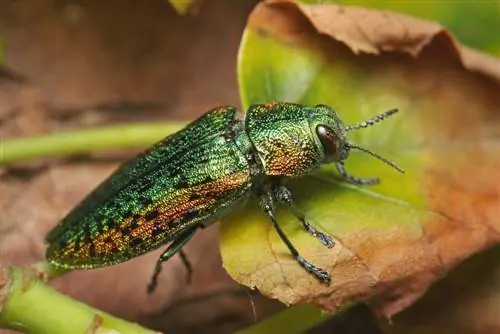
The jewel beetle lives up to its name
With a little luck, you can admire one of the most beautiful jewel beetles near Linden. You can recognize lime tree beetles by this picturesque look:
- 9 to 15 mm in size
- Base color metallic green
- Abdomen metallic blue
- Top wing with shiny red gold border
Soft Beetle - Common Soft Beetle (Cantharis fusca)
Soft beetles are also popularly known as soldier beetles because of their colorful uniform. The common soft beetle, which is characterized by these identifying characteristics, sets a good example:
- 11 to 15 mm
- slim body shape
- red base color, black cover wings
- Abdomen bright orange
The common soft beetle spices up its long, thread-like antennae with contrasting colors. The first segments near the head shine in elegant red. The remaining antenna segments are matt black.
Tip
Who is the most beautiful in the local beetle country? Numerous beetle species in Germany are in a neck-and-neck race to find the answer. The golden rose beetle (Cetonia aurata) from the scarab beetle family has the best chance of winning the title, closely followed by iridescent jewel beetles such as the native species of cherry beetle (Anthaxia candens). Bright sealing wax-red lily beetles (Lilioceris lilii) from the leaf beetle family are beautiful to look at, but they feed on flowers and leaves, which significantly affects the chances of winning the title.
Frequently asked questions
What are these beetles with long antennae?
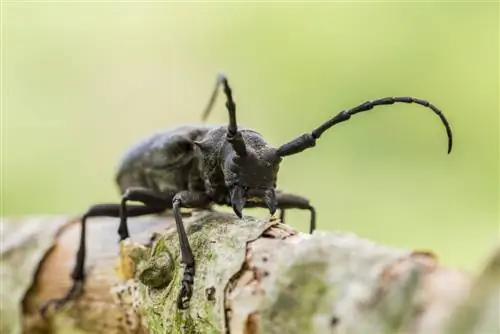
The family of long-sensing longhorn beetles is huge
Several beetle species in Germany boast long antennae. Leading the way are the longhorn beetles (Cerambycidae), whose antennae significantly exceed their body length. In this respect, domestic beetles and their fellow beetles are the ibexes among domestic beetles. Furthermore, soft beetles (Cantharidae) carry impressively long antennae in front of them.
Can all native beetles fly?
The vast majority of native beetles can fly. Of course, a body with two pairs of wings is no guarantee that a beetle can actually fly. A prime example is the black weevil (Otiorhynchus sulcatus) from the weevil family (Curculionidae). Over the course of evolution, the large black beetles have chosen to live on the ground. As a result, the two armor-like wings have now grown together.
How can beetles be distinguished from other insects?
You can clearly distinguish a beetle from other insects by the structure of its body and wings. Visible from the body of a beetle are the head, pronotum and cover wings. The body parts of the chest and abdomen, which are recognizable in other insects, form an optical unit under the cover wings in beetles. The flying machine itself is made up of two pairs of wings. The mostly hardened cover wings lie protectively over the membranous wings. The latter can only be seen when beetles are flying.
Tip
Some local insects have the look of a beetle and put nature lovers on the slippery slope when it comes to identification. Prime examples are large bug species such as fire bugs (Pyrrhocoris apterus), stripe bugs (Graphosoma lineatum) or the green stink bug (Palomena prasina). American bed bugs (Leptoglossus occidentalis) even have the risk of confusion in their name. Anyone who knows their way around will no longer fall for this deceptive maneuver. You can read about the five most important differences between bedbugs and beetles here.

